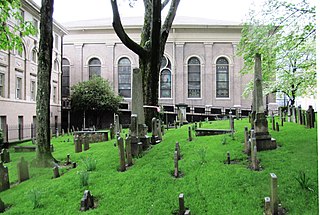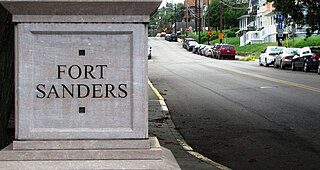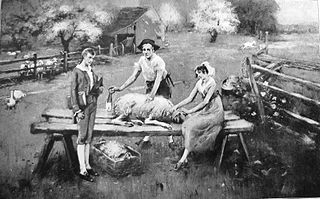
Sevierville is a city in and the county seat of Sevier County, Tennessee, United States, located in eastern Tennessee. The population was 17,889 at the 2020 United States Census.

Hugh Lawson White was an American politician during the first third of the 19th century. After filling in several posts particularly in Tennessee's judiciary and state legislature since 1801, thereunder as a Tennessee Supreme Court justice, he was chosen to succeed former presidential candidate Andrew Jackson in the United States Senate in 1825. He became a member of the new Democratic Party, supporting Jackson's policies and his future presidential administration. However, he left the Democrats in 1836 and was a Whig candidate in that year's presidential election.

John Sevier was an American soldier, frontiersman, and politician, and one of the founding fathers of the State of Tennessee. A member of the Democratic-Republican Party, he played a leading role in Tennessee's pre-statehood period, both militarily and politically, and he was elected the state's first governor in 1796. He served as a colonel of the Washington District Regiment in the Battle of Kings Mountain in 1780, and he commanded the frontier militia in dozens of battles against the Cherokee in the 1780s and 1790s.
James White was an American pioneer and soldier who founded Knoxville, Tennessee, in the early 1790s. Born in Rowan County, North Carolina, White served as a captain in the county's militia during the American Revolutionary War. In 1783, he led an expedition into the upper Tennessee Valley, where he discovered the future site of Knoxville. White served in various official capacities with the failed State of Franklin (1784–1788) before building James White's Fort in 1786. The fort was chosen as the capital of the Southwest Territory in 1790, and White donated the land for a permanent city, Knoxville, in 1791. He represented Knox County at Tennessee's constitutional convention in 1796. During the Creek War (1813), White served as a brigadier general in the Tennessee militia.

Sequoyah Hills is a neighborhood in Knoxville, Tennessee, United States, named for the Cherokee scholar Sequoyah. It is located off Kingston Pike, between the city's downtown and West Knoxville. Initially developed in the 1920s, Sequoyah Hills was one of Knoxville's first suburbs and today is home to some of the city's most affluent residents. The neighborhood contains numerous notable examples of mid-20th century residential architecture, with houses designed by architects such as Charles I. Barber, Benjamin McMurry, and Francis Keally.

The Ramsey House is a two-story stone house in Knox County, Tennessee, United States. Also known as Swan Pond, the house was constructed in 1797 by English architect Thomas Hope for Colonel Francis Alexander Ramsey (1764–1820), whose family operated a plantation at the site until the U.S. Civil War. In 1969, the house was added to the National Register of Historic Places for its architecture and its role in the region's early 19th-century history.

The James Park House is a historic house located at 422 West Cumberland Avenue in Knoxville, Tennessee, United States. The house's foundation was built by Governor John Sevier in the 1790s, and the house itself was built by Knoxville merchant and mayor, James Park (1770–1853), in 1812, making it the second-oldest building in Downtown Knoxville after Blount Mansion. The house is listed on the National Register of Historic Places, and currently serves as the headquarters for the Gulf and Ohio Railways.
This is a list of the National Register of Historic Places listings in Knox County, Tennessee.

The Craighead–Jackson House is a historic two-story, brick house in Knoxville, in the U.S. state of Tennessee. The home was constructed by John Craighead in 1818 across the street from the William Blount Mansion. The house is on the National Register of Historic Places.

The First Presbyterian Church Graveyard is the oldest graveyard in Knoxville, Tennessee, United States. Established in the 1790s, the graveyard contains the graves of some of Knoxville's most prominent early residents, including territorial governor and Constitutional Convention delegate William Blount and Knoxville founder James White. In 1996, the graveyard was added to the National Register of Historic Places.
The East Tennessee Historical Society (ETHS), headquartered in Knoxville, Tennessee, United States, is a non-profit organization dedicated to the study of East Tennessee history, the preservation of historically significant artifacts, and educating the citizens of Tennessee. The society operates a museum and museum shop in the East Tennessee History Center on Gay Street in downtown Knoxville. The East Tennessee Historical Society was established in 1834, 38 years after the establishment of the state of Tennessee, to record the history of the development and settlement of the area.

Citico is a prehistoric and historic Native American site in Monroe County, Tennessee, in the southeastern United States. The site's namesake Cherokee village was the largest of the Overhill towns, housing an estimated Indian population of 1,000 by the mid-18th century. The Mississippian village that preceded the site's Cherokee occupation is believed to have been the village of "Satapo" visited by the Juan Pardo expedition in 1567.

Fort Sanders is a neighborhood in Knoxville, Tennessee, USA, located west of the downtown area and immediately north of the main campus of the University of Tennessee. Developed in the late 19th century as a residential area for Knoxville's growing upper and middle classes, the neighborhood now provides housing primarily for the university's student population. The neighborhood still contains a notable number of its original Victorian-era houses and other buildings, several hundred of which were added to the National Register of Historic Places in 1980 as the Fort Sanders Historic District.

James Gettys McGready Ramsey was an American historian, physician, planter, slave owner, and businessman, active primarily in East Tennessee during the nineteenth century. Ramsey is perhaps best known for his book, The Annals of Tennessee to the End of the Eighteenth Century, a seminal work documenting the state's frontier and early statehood periods. Ramsey was also a major advocate for development in East Tennessee, leading efforts to bring railroad access to the region, and helping to organize the region's first medical society.
Thomas Hope was an English-born American architect and house joiner, active primarily in Knoxville, Tennessee. Trained in London, Hope moved to Knoxville in 1795 where he designed and built several of the city's earliest houses. At least two houses built by Hope—the Ramsey House (1797) in east Knoxville and Statesview in West Knoxville— are still standing and have been listed on the National Register of Historic Places.

Samuel Czar Carrick was an American Presbyterian minister who was the first president of Blount College, the educational institution to which the University of Tennessee traces its origin.

The History of Knoxville, Tennessee, began with the establishment of James White's Fort on the Trans-Appalachian frontier in 1786. The fort was chosen as the capital of the Southwest Territory in 1790, and the city, named for Secretary of War Henry Knox, was platted the following year. Knoxville became the first capital of the State of Tennessee in 1796, and grew steadily during the early 19th century as a way station for westward-bound migrants and as a commercial center for nearby mountain communities. The arrival of the railroad in the 1850s led to a boom in the city's population and commercial activity.
Richard Owen Currey (1816–1865) was an American academic, physician and Presbyterian minister. He was a professor at the University of Nashville and the publisher of agrarian and medical journals. During the American Civil War, he was a surgeon and chaplain for the Confederate States Army.
Samuel Ramsey Rodgers was an American attorney, judge and politician, who served as Speaker of the Tennessee Senate during the months following the Civil War. He oversaw the passage of several important pieces of legislation in the senate, including the state's ratification of the Thirteenth Amendment to the U.S. Constitution. Rodgers remained loyal to the Union during the war, and chaired the convention that reorganized the state government in January 1865.














